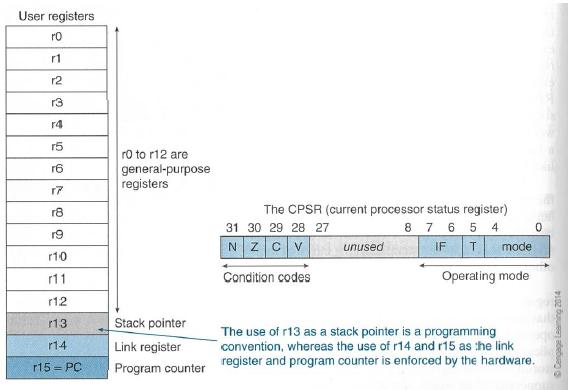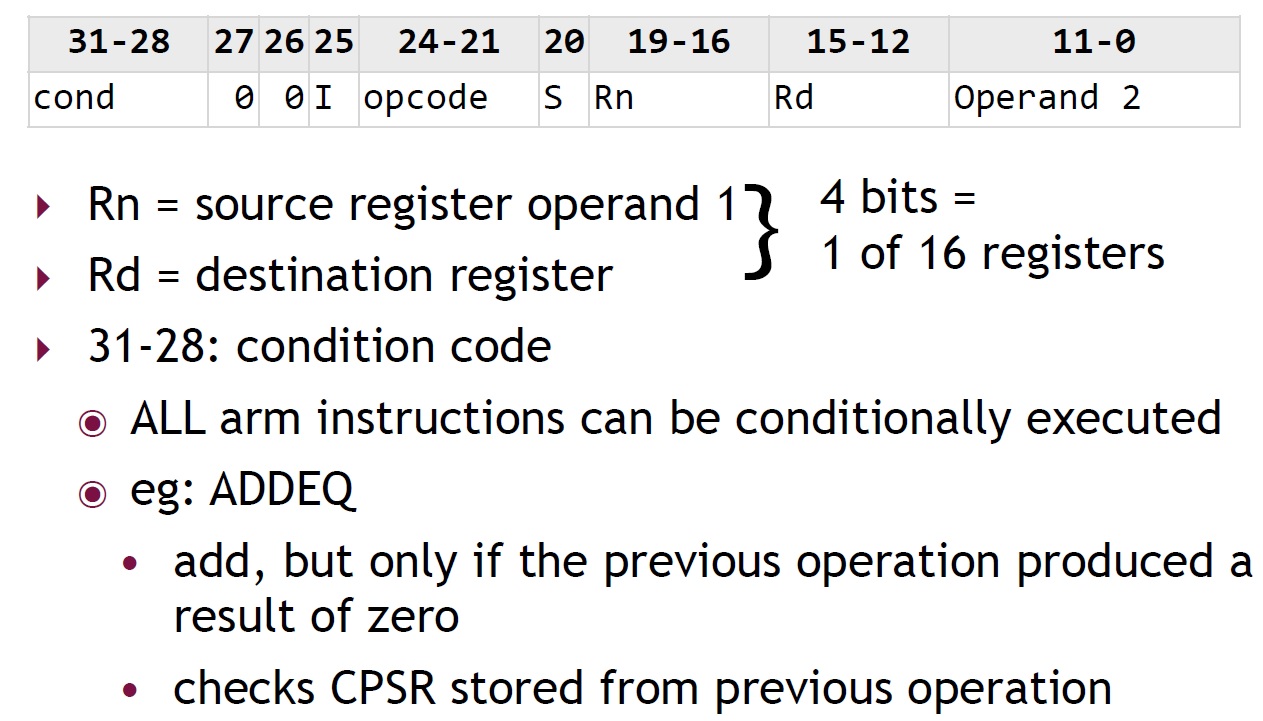
1. To investigate Arithmetic Operations and more other instructions. 2. To implement them in Keil uVision5.
As mentioned in the previous lab, ARM has 16 programmer-visiable registers
and a Current Program Status Register, CPSR.
Here is a picture to show the ARM register set.

R0 to R12 are the general-purpose registers. R13 is reserved for the programmer to use it as the stack pointer. R14 is the link register which stores a subroutine return address. R15 contains the program counter and is accessible by the programmer. CPSR: current program status register (32 bit) Stores the status of the previous ALU operation. 4 flags N = 1, if result was negative Z = 1, if result was zero C = 1, if result had a carry-out V = 1, if result was an overflow These can be used to make decisions later on.Each ARM instruction is encoded into a 32-bit word. Access to memory is provided only by Load and Store instructions.
ARM instructions have the following general format:
Label Op-code operand1, operand2, operand3 ; comment
Arithmetic instructions are very basic and frequently used in your
ARM programming.
Here is a table that demonstrates the usage of the ARM
processor's arithmetic instructions with examples.
Instruction Mnemonic Meaning ======================================================================== Addition ADD R0, R1, R2 ; R0 = R1 + R2 ------------------------------------------------------------------------ Addition ADDS R0, R1, R2 ; R0 = R1 + R2, ; and FLAGs are updated ------------------------------------------------------------------------ Subtraction SUB R1, R2, R3 ; R1 = R2 - R3 ------------------------------------------------------------------------ Subtraction SUBS R1, R2, R3 ; R1 = R2 - R3, ; and FLAGs are updated ------------------------------------------------------------------------ SUBS R7, R6, #20 ; R7 = R6 - 20 ; Sets the flags on the result ------------------------------------------------------------------------ Reverse Subtraction RSB R4, R4, #120 ; R4 = 120 - R4 ------------------------------------------------------------------------ Multiply MUL R0, R1, R2 ; R0 = R1 * R2 ------------------------------------------------------------------------ Division SDIV R0, R2, R4 ; Signed divide, R0 = R2/R4 ------------------------------------------------------------------------ UDIV R8, R8, R1 ; Unsigned divide, R8 = R8/R1. ------------------------------------------------------------------------
Mnemonic Meaning
------------------------------------------------------------------------
MOV R1, #0xFA05 ; Write value of 0xFA05 to R1, flags are not updated
------------------------------------------------------------------------
MOVS R11, #0x000B ; Write value of 0x000B to R11, flags get updated
------------------------------------------------------------------------
MOVS R10, R12 ; Write value in R12 to R10, flags get updated
------------------------------------------------------------------------
MOV R3, #23 ; Write value of 23 to R3
------------------------------------------------------------------------
MOV R8, SP ; Write value of stack pointer to R8
------------------------------------------------------------------------
MVNS R2, #0xF ; Write value of 0xFFFFFFF0 (bitwise inverse of 0xF)
; to the R2 and update flags.
------------------------------------------------------------------------
------------------------------------------------------------------------ AND R9, R2, R1 ; R9 = R2 AND R1 ------------------------------------------------------------------------ AND R9, R2, #0xFF00 ; R9 = R2 AND #0xFF00 ------------------------------------------------------------------------ ORR R9, R2, R1 ; R9 = R2 OR R1 ------------------------------------------------------------------------ ORR R9, R2, #0xFF00 ------------------------------------------------------------------------ ORREQ R2, R0, R5 ------------------------------------------------------------------------ ANDS R9, R8, #0x19 ------------------------------------------------------------------------ EOR R7, R11, R10 ; R7 = R11 XOR R10 ------------------------------------------------------------------------ EORS R7, R11, #0x18181818 ------------------------------------------------------------------------ BIC R0, R1, #0xab ; R0 = R1 AND (NOT(#0xab)) ------------------------------------------------------------------------ ORN R7, R11, R14, ROR #4 ; R7 = R11 OR (NOT(R14 ROR #4)) ------------------------------------------------------------------------ ORNS R7, R11, R14, ROR #2 ; update the flags ------------------------------------------------------------------------
Each ARM instruction is encoded into a 32-bit word.
The basic encoding format for the instructions such as
Load, Store, Move, Arithmetic, and Logic instructions, is as follows:

An instruction specifies a conditional execution code
(Condition), the OP code, two or three registers (Rn, Rd,
and Rm), and some other information.
Here is a more detailed description.
All the ARM instructions are conditionally executed depending on a condition specified in the instruction(bits 31-28).
For example: CMP R0, #25 ; flags are updated according to (R0 - #25) ADDGT R1, R2, #12
------------------------------------------------------------------------ LSL R4, R5, #2 ; Logical shift left by 2 bits ------------------------------------------------------------------------ LSR R4, R5, #6 ; Logical shift right by 6 bits ------------------------------------------------------------------------ LSLS R1, R2, #3 ; Logical shift left by 3 bits with flag update ------------------------------------------------------------------------ ROR R4, R5, R6 ; Rotate right by the value in the bottom byte of R6 ------------------------------------------------------------------------ RRX R4, R5 ; Rotate right with extend (one bit only). ------------------------------------------------------------------------Here is a link for your references:
Cortex-M3 Devices Generic User Guide. Section 3.5 and 3.6.
;The semicolon is used to lead an inline documentation
;
;When you write your program, you could have your info at the top document block
;For Example: Your Name, Student Number, what the program is for, and what it does etc.
;
; This program will catculate the value of the following function:
; f(x) = 5x^2 - 6x + 8 when x = 7.
;
;;; Directives
PRESERVE8
THUMB
; Vector Table Mapped to Address 0 at Reset
; Linker requires __Vectors to be exported
AREA RESET, DATA, READONLY
EXPORT __Vectors
__Vectors
DCD 0x20001000 ; stack pointer value when stack is empty
DCD Reset_Handler ; reset vector
ALIGN
; The program
; Linker requires Reset_Handler
AREA MYCODE, CODE, READONLY
ENTRY
EXPORT Reset_Handler
Reset_Handler
;;;;;;;;;;User Code Start from the next line;;;;;;;;;;;;
MOV R0, #7 ; x = 7
MUL R1, R0, R0 ; R1 = x^2
MOV R4, #5
MUL R1, R1, R4
MOV R5, #6
MUL R2, R0, R5 ; R2 = 6x
SUB R3, R1, R2 ; R3 = 5x^2 - 6x
ADD R3, R3, #8 ; R3 = 5x^2 - 6x + 8
ALIGN
STOP
B STOP
END ; End of the program
LDR dest, expression
LDR R6, [R4] ; load R6 with the value in the memory whose address is in R4
STR STR{cond} srce,[base],offset
STR R0,[R1] ; store R0 in the byte address R1
STR R0,[R1,#20] ; store R0 in the byte address R1+20
STR R0,[R1,R2,LSL#2] ; store R0 in the address given by R1+R2*4
Examples:
LDR R0, NUM ; load R0 with the value of NUM in memory
LDR R6, = NUM ; Load the address of NUM to R6
MOV R0, #0x001C ; Load the value to the R0
STR R0, [R6] ; Store the value in R0 to NUM
;The semicolon is used to lead an inline documentation
;When you write your program, you could have your info at the top document block
;For Example: Your Name, Student Number, what the program is for, and what it does etc.
;
; See if you can figure out what this program does
;
;;; Directives
PRESERVE8
THUMB
; Vector Table Mapped to Address 0 at Reset
; Linker requires __Vectors to be exported
AREA RESET, DATA, READONLY
EXPORT __Vectors
__Vectors
DCD 0x20001000 ; stack pointer value when stack is empty
DCD Reset_Handler ; reset vector
ALIGN
;Your Data section
;AREA DATA
SUMP DCD SUM
NUM1 DCD 5
NUM2 DCD 7
; The DCD directive allocates one or more words of memory,
; aligned on four-byte boundaries,
; and defines the initial runtime contents of the memory.
;
; For example, data1 DCD 1,5,20
; Defines 3 words containing decimal values 1, 5, and 20
AREA MYRAM, DATA, READWRITE
SUM DCD 0
; The program
; Linker requires Reset_Handler
AREA MYCODE, CODE, READONLY
ENTRY
EXPORT Reset_Handler
Reset_Handler
;;;;;;;;;;User Code Start from the next line;;;;;;;;;;;;
LDR R1, NUM1
LDR R2, NUM2
MOV R0, #0
ADD R0, R1, R2
SUBS R0, R0, #1
LSLS R3, R0, #2 ; Logical shift left by 2 bits with flag update
LDR R4, SUMP
STR R3, [R4]
LDR R6, [R4]
ALIGN
STOP
B STOP
END
|
Monday, 28-Feb-2022 16:18:51 CST |
|